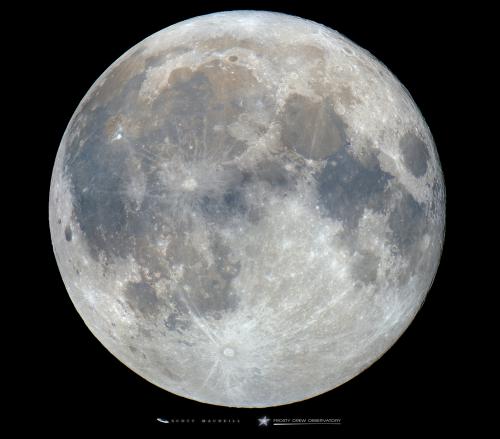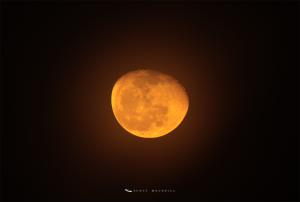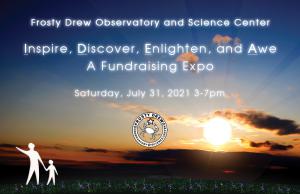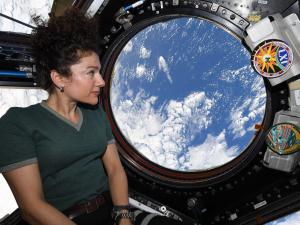Celebration of Space - July 23, 2021

The Harvest Moon captured with the primary 16-inch telescope at Frosty Drew Observatory by Frosty Drew Astronomy Team member Scott MacNeill.
At 10:37 pm on Friday, July 23, 2021 the July Full Moon will occur. Commonly referred to as the Buck Moon, the July Moon is the second full lunar phase in a series of four lunar phases this summer (2021). The name of the July Moon comes from North American and European lore as the time of the year that male deer will begin to grow new antlers for the year, which they shed annually. Another common, and certainly more appropriate, name for the July Moon is the Thunder Moon. This name needs no explanation this summer, as the daily occurrence of thunderstorms over the past several weeks speak the name of the July Moon. Regarding perigee and apogee, the July Moon is certainly near perigee (closest to Earth for its orbital period), which happened on July 21st. Though at Frosty Drew we would not consider this a perigee syzygy (supermoon). Regardless, step outside tonight and celebrate the nicer weather with the mid-summer Full Moon.
Over the past week have you noticed how red the Sun has been at sunrise and sunset? How about the deep yellow hue of the Moon on the nights it has been visible? Many readers associate the hot summer days with this phenomenon, and though humidity certainly plays a role in the ruddy color, it is not the heat that directly does it, but instead it’s the result of an increase in wildfire smoke over our region. August brings the smoke from wildfires happening in Canada and the US West. Normally blue light is scattered in Earth’s atmosphere from a process known as Rayleigh Scattering, where nitrogen and oxygen molecules will scatter the higher energy side of the visible spectrum (blue). Smoke molecules like carbon monoxide, and sulfur dioxide alongside airborne particulates (ash) are much larger than nitrogen and oxygen molecules, and will start to scatter the green wavelengths of the visible spectrum, with heavy smoke scattering the red wavelengths as well. This is called Mie Scattering and is why we see the smokey daytime sky as white, and even red under heavy conditions, instead of the usual blue. Since nearly all blue moonlight is scattered and some of the green moonlight, due to smoke passing over our region, we see the Moon in a ruddy yellow / pink hue.
Even though wildfire smoke brings beautiful views of the Sun and Moon, it also has some unfortunate consequences on our view of the night sky. Specifically the annual Perseid Meteor Shower, which peaks during the second week of August. The intense increase in smoke frequently smokes out our view of the stunning Perseid peak period, causing the Perseid peak to be rather uncommon to view in the Northeast. Predicting smoke concentrations for a specific time comes down to local conditions over areas prone to wildfires as well as the jet stream, which will carry the smoke. So far in 2021, the Pacific Northwest, and western Canada has seen record-breaking heat, which will certainly increase the likelihood of wildfires, some of which have already begun. As for the jet stream, we will have to see what happens.
At Frosty Drew Observatory and Science Center we are getting quite excited about our Inspire, Discover, Enlighten, and Awe (IDEA) Expo Fundraising event which will happen on July 31, 2021 in the afternoon. This is a big day for Frosty Drew to raise awareness of the amazing things that are to come with the addition of our new Planewave CDK600 telescope. It’s also an important day for Frosty Drew in raising support, through funding, for the expansion of our operations through 2021. The generous support of so many is what enables Frosty Drew to inspire children about their potential to walk on Mars, to enlighten thousands of people each year with the amazement of the cosmos, and to help everyone discover their place in the Universe by introducing our visitors to a cosmic perspective. These are the most important functions of Frosty Drew and every team member is so thankful for the opportunity to do so. Please visit our GoFundMe (https://gofund.me/5e00678a) page to learn how you can support Frosty Drew Observatory and Science Center this year. Then visit our event page to learn more about our IDEA Expo (https://frostydrew.org/IDEA-Expo) that is taking place on July 31st.
Evening passes of the International Space Station (ISS) continue over the Northeast this week, and with the prospect of clearer sky conditions in the evening, we could catch up on missed passes due to clouds lately. Even though there aren’t many spectacular passes in store for this week, several passes will be well worth the trip outside of your door. Here are notable passes for this weekend and coming week:
Fri, Jul 23 at 11:21 pm, starting in the NW, rising to 29°, and into orbital sunset
Sat, Jul 24 at 10:34 pm, starting in the NW, rising to 24°, and into orbital sunset
Sun, Jul 25 at 9:46 pm, starting in the NNW, rising to 19°, heading towards the ENE
Mon, Jul 26 at 10:36 pm, starting in the NW, rising to 46°, and into orbital sunset
Tue, Jul 27 at 9:48 pm, starting in the NW, rising to 32°, heading towards the ENE and into orbital sunset
Wed, Jul 28 at 9:01 pm, starting in the NW, rising to 24°, heading towards the ENE
Wed, Jul 28 at 10:38 pm, starting in the WNW, rising to 43°, and into orbital sunset
Thu, Jul 29 at 9:50 pm, starting in the NW, rising to 77°, heading towards the ESE, and into orbital sunset ← Awesome Pass!
Evening passes of the ISS will continue over our region until August 3, 2021. So make it a fun summer thing to step outside with your friends, family, or just your fabulous self and catch stunning views of humanity’s only continuously inhabited space-based residency passing over. For daily pass times of the ISS and other bright satellites visit our website daily at: https://frostydrew.org/observatory/#satellites
- Author:
- Scott MacNeill
- Entry Date:
- Jul 23, 2021
- Published Under:
- Scott MacNeill's Columns




